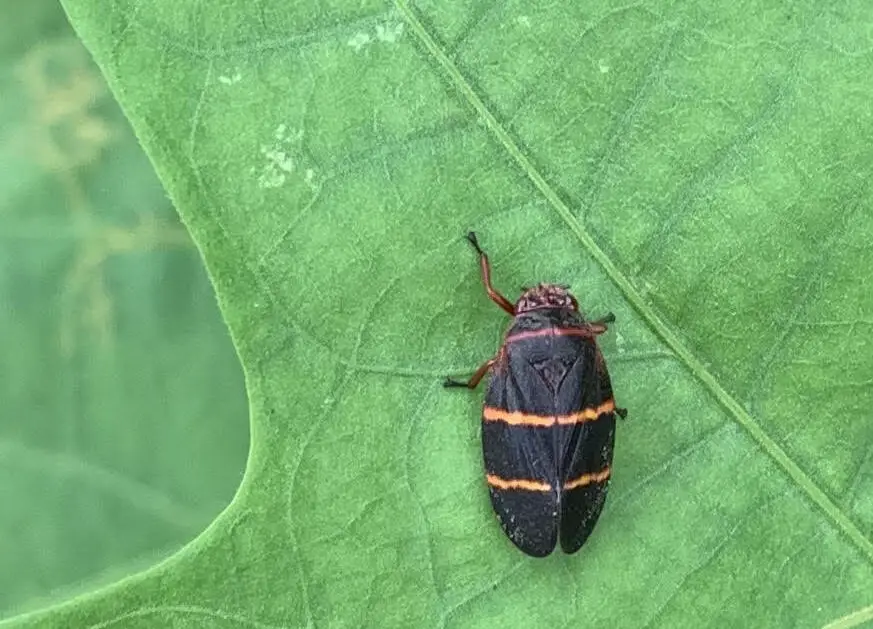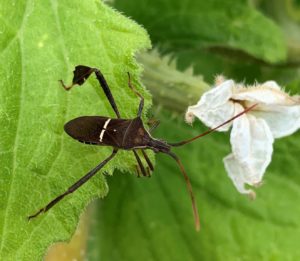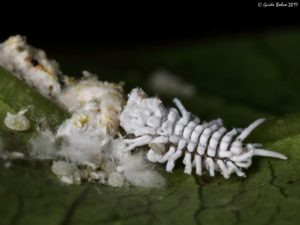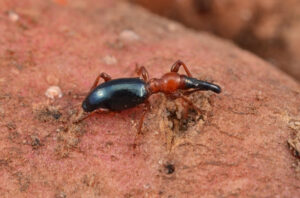Two lined spittlebugs, like leafhoppers, are small, wedge-shaped insects. Their dark brown to black bodies measure approximately 3/8 inch long (9.5 cm). They have two parallel red-orange lines across their folded wings and another one across their thorax. In addition, they have red eyes and red legs.
Adults do not usually fly, even though they have wings. Instead, they hop great distances when necessary. Indeed, adults of this and other spittlebug varieties are sometimes referred to as froghoppers because of their ability to jump and because some believe their face resembles a frog.
Nymphs are smaller than adults. Their white to yellow to orange bodies are wingless. Their brown head and red eyes are easily identifiable.
The tiny insect derives its name from the spittle-like foam it creates as a nymph. The immature insect sucks plant sap out with its needle-like mouthparts, then excretes the excess in its urine. When the urine is combined with air forced from its abdomen, it creates a sticky, bubbly mass. The bug then uses its back legs to gather the foam to spread over itself. The foamy mass protects the nymph from predators, desiccation (drying out), and temperature extremes. Nymphs are able to move between food sources, where they will, once again, create a spittle sanctuary.
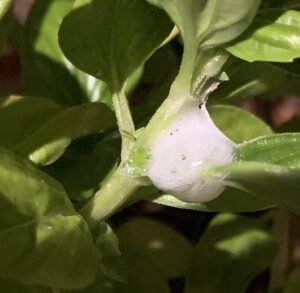
Like aphids and whiteflies, spittlebugs suck the sap from plant tissue. In general, they feed on a variety of plants, including vegetable plants like beans, peas, and other legumes, because of their amino acid-rich sap. Some spittlebugs also feed on ornamentals like asters, roses, morning glories, daises, and goldenrod. The two lined spittlebug most often feeds on weeds and grasses, such as St. Augustine, Centipede, Bermuda, Zoysia, and Bahia.
Adults are more active in the early hours or at night as they tend to hide in the soil’s surface during the heat of the day. They thrive in rainy, warm climates and are widely found throughout the United States, as well as Mexico and Central and South America.
Spittlebug Life Cycle
During its lifetime, a female adult can lay up to 40 tiny orange oblong eggs. The eggs are laid individually or in clusters at the base of grass blades, near the soil’s surface, where the leaves attach to the plant stem, or at a branch juncture.
Spittlebugs overwinter in the egg stage. They hatch in spring and summer months and begin to feed on plant sap. Within just a few minutes of hatching, the pale yellow to white nymphs begin to excrete the foamy spittle. The active little bugs can produce about two hundred times their body weight in spittle every day. After their final molt, however, the nymphs-turned-adults no longer produce spittle. Adults live up to three weeks or sometimes longer in warmer climates.
Adults exhibit reflex bleeding, which is the discharge of hemolymph (i.e., insect blood) from their pretarsal pads (feet). The secretion’s foul taste and odor serves to deter predators.

How They Damage Plants and Grasses
Both adults and nymphs have needle-like mouthparts that are used to puncture plant tissue so as to suck out sap. Large numbers of spittlebugs can weaken plants, stunt growth, and reduce yields. In grasses, they may cause purple or white stripes and decay of grass blades.
Treatment Options
The occasional spittlebug poses little to no threat to the home garden, so treatment may not be necessary. But if you find more of these little sap suckers in your garden or lawn, here are some natural treatment options.
1. Use a blast of water from the hose to dislodge nymphs and the foam. This, in effect, removes their protection and exposes them to predators and desiccation.
2. Pick off the adult insects and nymphs by hand and dispose of them in a small container of soapy water.
3. Treat affected plants with an organic insecticidal soap. You can easily make your own by adding one teaspoon of a chemical-free Castile soap (Dr. Bonner’s or Dr. Wood’s) to a one-quart spray bottle filled with water and mix well by shaking. For larger applications, add four teaspoons of Castile soap to one gallon of water in a pump sprayer. Mix well. Do a test spray on one leaf and wait 24-48 hours to see if there are any adverse reactions. If so, dilute the spray and retest. Spray the entire plant, including the underside of leaves, in the early morning or early evening because the spray can burn plant tissue when exposed to bright sun.
5. Use an organic, cold-pressed neem oil that contains the natural ingredient Azadarachtin. You can learn more about neem oil in this article. This is the brand I use. As with all sprays, always do a test spray and do not spray during the heat of the day, as the combination of sun and spray can burn the plant.
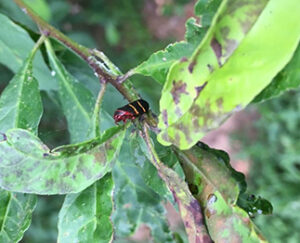
6. Apply an organic “hot” spray by blending ½ cup of diced hot peppers, six cloves of garlic, and two cups of water. Let the mixture sit for 24 hours, then strain it. Add two teaspoons of a non-chemical soap like Castile soap. Do a test spray on a leaf of two. If no damage occurs after 24-42 hours, you can proceed. Hose off any spittle foam you find, and then spray the plant with the mixture. Spray in the early morning and evenings so as to avoid any potential problems with the mixture interacting with the sun.
7. Encourage natural predators such as beneficial ladybugs, lacewings, parasitic wasps, and praying mantises to visit your garden or purchase them online.
Prevention Tips
1. The best thing you can do to prevent disease and insects of all kinds is to maintain healthy plants. Weakened plants are a target for insects and diseases.
2. As for grasses, dethatching goes a long way to prevent infestation, especially when accompanied by a top dressing of sand. You can also keep a lawn healthy by watering, mowing, and fertilizing it appropriately.
3. Remove weeds and plant debris that can harbor adults, eggs, and nymphs.
4. Routinely inspect your plants for insect activity. The earlier a problem is detected, the sooner it can be remedied.
5. Install row covers early in the growing season to prevent the bugs from accessing coveted plants.
Other Spittlebug Varieties
Other common varieties of spittlebugs include the meadow spittlebug, which varies in color from tan, gray, brown, and black. This variety has black spots at the head, which some misidentify as nostrils. They also have two ridges above the antennae, as well as visibly raised veins on the wings. The nymphs are green and sport dark antennae. This kind of spittlebug poses more of a garden and agricultural threat due to their eating preferences.
The dogwood spittlebug, which primarily feeds on dogwood trees and blueberries, is black and yellow with yellow stripes on its head. There is also a yellow mark on the forewings, and it has yellow legs.
The red-legged spittlebug has a black body and is sometimes called the black spittlebug. It has red eyes and black legs with red joints. It is similar to the two-legged spittlebug, except it does not have red or orange bands, and its legs are not all red.
The diamondback spittlebug has a dark diamond pattern on its tan body, hence the name.
Here is more information about garden insects, both harmful and beneficial.
